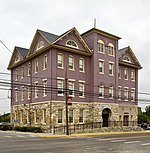Aspen Hill (Charles Town, West Virginia)
Eastern Panhandle Registered Historic Place stubsGreek Revival houses in West VirginiaHouses completed in 1840Houses in Jefferson County, West VirginiaHouses on the National Register of Historic Places in West Virginia ... and 3 more
National Register of Historic Places in Jefferson County, West VirginiaPlantation houses in West VirginiaUse mdy dates from January 2019
Aspen Hill is a farmhouse, built about 1840 near Charles Town, Virginia (now in West Virginia), by James G. Hurst, a middle-tier farmer and landowner, who sought to build a residence befitting his rising status. The house occupies a middle ground between the grand mansions of the landed gentry and the more humble dwellings of more modest farmers. The house lacks some of the details and craftsmanship present in more substantial houses.
Excerpt from the Wikipedia article Aspen Hill (Charles Town, West Virginia) (License: CC BY-SA 3.0, Authors).Aspen Hill (Charles Town, West Virginia)
North Mildred Street,
Geographical coordinates (GPS) Address Nearby Places Show on map
Geographical coordinates (GPS)
| Latitude | Longitude |
|---|---|
| N 39.321666666667 ° | E -77.862222222222 ° |
Address
North Mildred Street
North Mildred Street
25438
West Virginia, United States
Open on Google Maps






